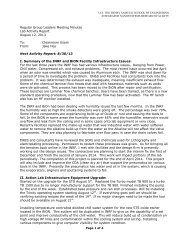Download Lab Safety Manual - Integrated Nanosystems Research ...
Download Lab Safety Manual - Integrated Nanosystems Research ...
Download Lab Safety Manual - Integrated Nanosystems Research ...
Create successful ePaper yourself
Turn your PDF publications into a flip-book with our unique Google optimized e-Paper software.
8 Specific Hazardous Gases<br />
8.1 Pyrophoric (flammable) Gases<br />
These gases will spontaneously ignite in air within a critical concentration range.<br />
‣ Silane (SiH4)<br />
It is used for deposition of polysilicon, amorphous silicon, nitride, oxide, and oxynitride films. It is a highpressure<br />
gas. When exposed to trace amounts of air or moisture, silica dust can form.<br />
‣ Dicholorsilane (SiH2CI2)<br />
It is used for deposition of polysilicon and amorphous silicon. It is low vapor pressure liquid source. Like silane,<br />
it will form dust when exposed to trace amounts of air and moisture.<br />
8.2 Corrosive Gases<br />
‣ Hydrochloric acid (HCI)<br />
HCI gas is extremely corrosive to almost everything, including stainless steel. HCI is used in the oxidation<br />
furnaces during steam cleaning.<br />
‣ Ammonia (NH3)<br />
NH3 gas is a severely corrosive alkaline vapor with a pungent odor. It is shipped in the cylinder as a liquid under<br />
its own vapor pressure of approximately 9 atm. NH3 gas is used in oxynitride and nitride film deposition (plasma<br />
and CVD).<br />
‣ Chlorine (Cl2)<br />
Cl2 gas is extremely corrosive, and can burn and damage eyes, skin, mucous membranes, and any other exposed<br />
tissue. It is shipped in the cylinder as a liquid under its own vapor pressure. The gas is used in REI systems.<br />
‣ Boron Trichloride (BCl3)<br />
BLC3 is a toxic and corrosive and can burn and damage eyes, skin, mucous membranes, and any other exposed<br />
tissue. It is shipped in the cylinder as a liquid under its own vapor pressure. The gas is used in REI systems<br />
8.3 Highly Toxic Gases<br />
These gases described here are severe pulmonary irritants and acute systemic poisons. Overexposure can cause<br />
either sudden or delayed death due to lung destruction. Although each has a characteristic smell, the odor<br />
threshold is not much lower than the toxic exposure level. The gases here are used as dopants in CVD, epi, and<br />
implanter systems.<br />
Xenon Difluoride (XeF2)<br />
XeF2 is a DANGEROUS! Oxidizing, toxic, corrosive solid may ignite or explode on contact with combustible<br />
materials. Contact with water or moisture generates toxic fumes. It is corrosive to the skin, eyes, respiratory tract,<br />
and mucous membranes. Under ambient conditions, this is a white solid with an ozone-like odor.<br />
Fluorine (5% He 95)<br />
Fluorine is a DANGEROUS! (Pale yellow gas with a pungent, irritating odor) DANGEROUS! Oxidizer. May be<br />
fatal if inhaled, Causes severe respiratory tract, eyes and skin burns. Can cause target organ damage, Contact with<br />
combustible material may cause fire contents under pressure.<br />
Nitrogen Dioxide (N02)<br />
.Nitrogen Dioxide is a DANGEROUS! Poisonous, corrosive, oxidizing liquid and gas under pressure, and may be<br />
fatal if inhaled. Can cause severe lung damage, can cause eye and skin burns. Symptoms may be delayed.<br />
Vigorously accelerates combustion. Under ambient conditions, this is a reddish-brown gas with an irritating odor.<br />
8.4 Non-toxic Gases<br />
20



